Does your wooden cutting board have a stubborn stained area? Or do you need to remove the strong odors coming from the board? By the end of reading this guide, you’ll understand how to properly clean a wooden cutting board and disinfect and remove odors from the board.
A wooden cutting board is one of the most important items to keep in good shape in your kitchen. Besides helping you make cutting easy, the board improves the kitchen’s aesthetics.
Cleaning wooden cutting boards is not as easy as you may assume. Sometimes, to ensure a properly cleaned wooden cutting board, you’ll have to use chemicals like hydrogen peroxide, white vinegar, and chlorine bleach, amongst others.
JUMP TO: Disinfecting Wooden Cutting Board | Cutting Board Maintenance | Bottomline |
- Wash your cutting board with dish soap and warm water regularly.
- Use a spray of white vinegar solution or 3% hydrogen peroxide to disinfect the board.
- If you have stubborn stains on your wooden cutting board, soak them in a mild bleach solution.
- You need to re-season your cutting board after every deep cleaning episode.
Methods to Disinfect Wooden Cutting Board
Cleaning and disinfecting your wooden cutting board is necessary to avoid cross-contamination of bacteria and keep your food safe.
Irrespective of the cleaning method you use, remember to rinse the board surface thoroughly and air dry before the next use.
Let’s check how to clean and disinfect a wooden cutting board.
With Soap and Water
The most common and quickest way to clean wooden cutting boards is by using soapy water and a clean sponge. This method may not be the surest way to prevent cross-contamination of bacteria, but it can remove stains.
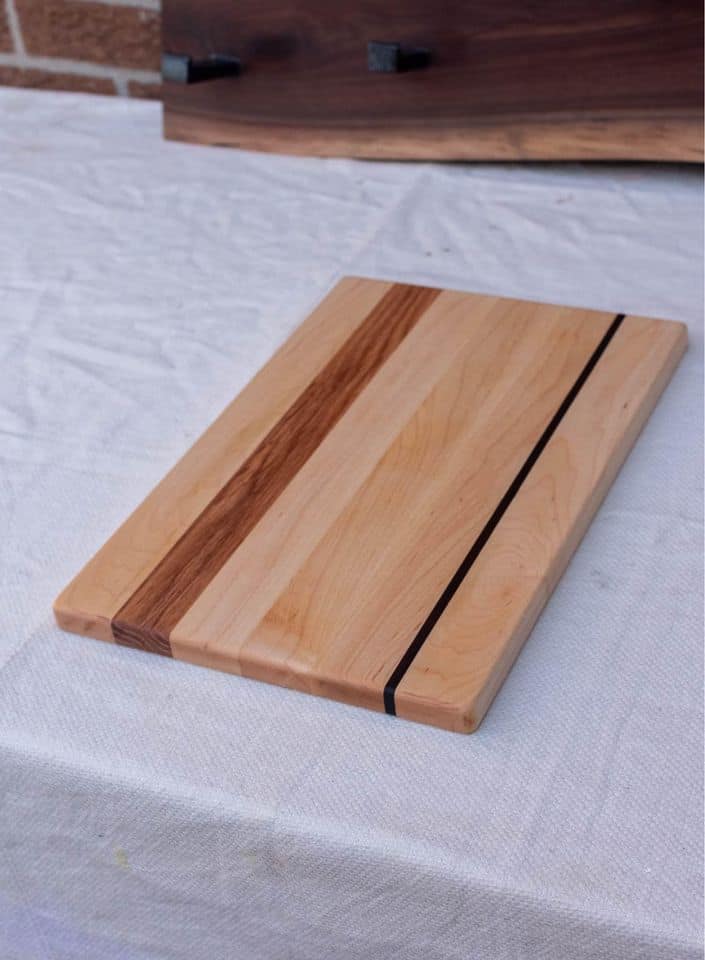
Luckily, your regular dish soap will suffice for the cleaning process. Here’s a list of materials you will need for this cleaning procedure;
- Dish soap
- Clean sponge
- Dishtowel
- Clean clothe
- Hot water
Here’s the step-by-step process to clean your wooden cutting board with soapy water:
- Rinse the entire surface of the wooden cutting board with hot water. While you rinse the board, wipe off every food item with a soft cloth. Don’t put your hands in when the hot water is still running.
- Mix your cleaning solution of dish soap and warm water. Remember to make enough soap to clean both sides of the wooden cutting board. Add a liberal amount of soap to the water.
- Apply the cleaning solution to the entire surface of the wooden cutting board and scrub with a clean sponge. Remember to wipe thoroughly with a clean sponge if there’s a stained area.
- Rinse the board with warm water to disinfect it and check if the wooden cutting board is clean. If it isn’t, repeat the washing process.
- After rinsing the board, you need to air dry completely. You will need to stand the board upright to get dried up quickly.
TIPS: You can use a clean cloth to clean the water off, so the drying time can be faster.
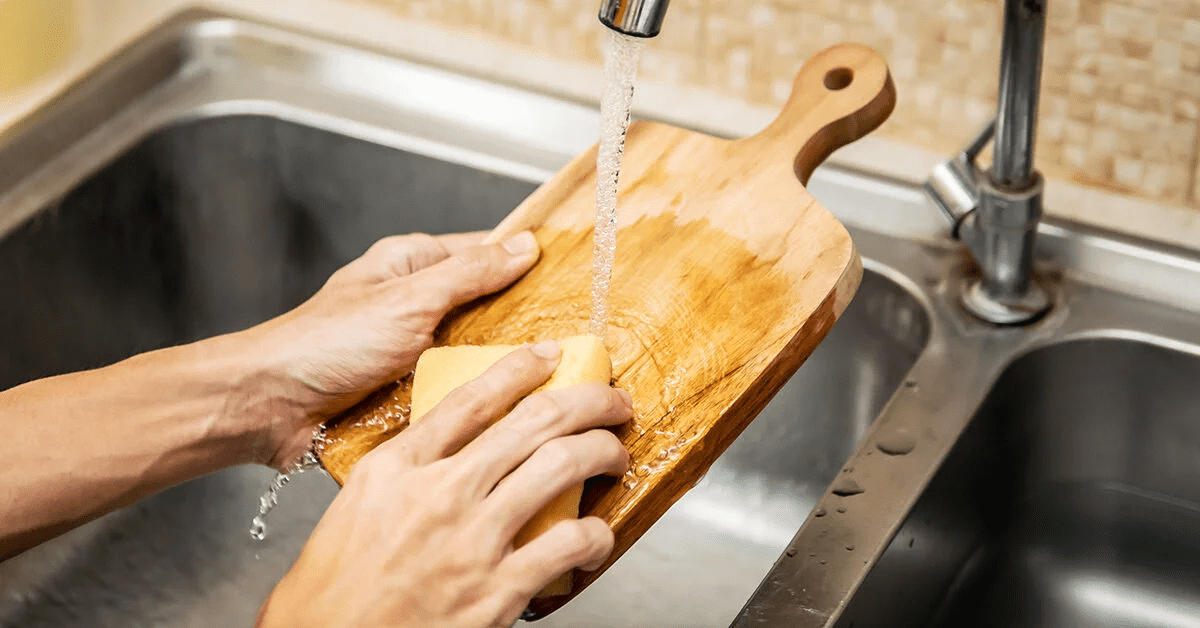
Source: Healthline.com
With Bleach
We are guilty of cutting almost anything on our boards – including raw meat, chicken, and others. These materials bring a lot of bacteria to wooden cutting boards, accompanied by bad odors, and the moisture further causes mold. And hand washing the wooden cutting will not be the ideal choice.
In this scenario, chlorine bleach is a better disinfectant option. According to research done by Washington State University, chlorine bleach is known for killing bacteria and removing stains in the cutting board. Don’t worry about the bleach concentration; it will work in a water solution.
Some of the materials needed include:
- Chlorine bleach
- Bowl
- One gallon of water
Also Read: Acacia Vs. Teak Cutting Board – Here’s What To Buy!
Here are the step-by-step instructions to clean a wooden cutting board with chlorine bleach;
- Make a mild chlorine bleach cleaning solution. The amount of chlorine bleach to add depends on the number of wooden cutting boards you want to clean and the space you have. One teaspoon of bleach is sufficient for one gallon of water.
- Immerse the surface of the boards into the bleach cleaning solution. The board’s surface needs to be in contact with the water surface for less than five minutes.
- Rinse the board thoroughly with warm or hot water.
- Wash the board with dish soap and a mild cleaning solution. The last thing you want on your wooden cutting board is chlorine bleach. After rinsing off the bleach, wash it with a sponge and water.
- Air dry the wooden cutting board. Only use the board for light before it dries completely if you have only one.
Tips: If the wooden cutting board has a large stain, scrub the area before rinsing the bleach off.
Also Read: Is Bamboo Wood Good for Cutting Boards?[8 Reasons Explained]
With White Vinegar
White vinegar is another disinfectant for your wooden cutting board, and it also helps to remove odors. White vinegar is usually available in many kitchens, so this may be a cheaper way to disinfect the cutting board.
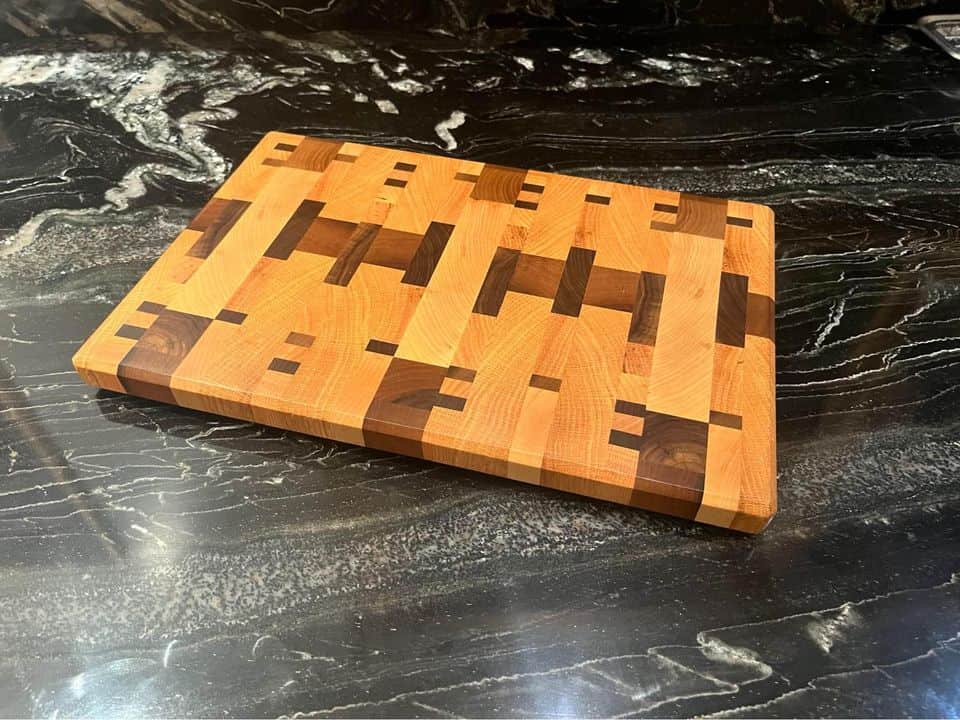
Here are the tools you will need to clean a wooden cutting board with white vinegar;
- Vinegar
- Spray bottle
- Water
The process is simple:
- Prepare a mix of white vinegar and water. The white vinegar should contain 25%, while the remaining mix is water. That means, for every cup of white vinegar, you pour four cups of water.
- Spray the board with the white vinegar solution. This solution will act as a protective barrier against bacteria on the board’s surface.
- Air dry the board. You need the vinegar to dry up on the board, as it helps remove odors.
Caution: This method may leave a vinegar taste on your wooden cutting board.
With Lemon or Lemon Juice
Lemon or lemon juice has high amounts of citric acid, which can help clean your wooden cutting board. You’ll need a bit of coarse salt for this process. Here is a full list of things needed for this disinfecting process;
- Get lemons or lemon juice. The amount obtained depends on the size and number of wood-cutting boards.
- Get coarse salt.
- Mild sponge.
Here’s the process of using lemon juice and salt to clean a wooden cutting board:
- Sprinkle kosher salt on the surface of the board. You can sprinkle kosher salt if you have one.
- Cut your lemons into equal halves or provide lemon juice. You can pour the lemon on the surface to mix with the salt.
- Scrub the board’s surface with either the lemons or the sponge (for the lemon juice).
- Rinse the board completely, and air dries the board. Ensure the box is completely dry by putting it in a tip-top shape so that water flows.
Tips: Using actual lemons is usually better because the fruit can scrub the surface.

Source: realestate.com.au
With Hydrogen Peroxide
In place of vinegar, hydrogen peroxide is another item you can use to disinfect a wooden cutting board and remove odors.
All you need is a hydrogen peroxide solution with a 3% concentration. Spray it on the surface of the wooden cutting board and leave it for less than five minutes.
Rinse and clean the surface of the board before you use it again.
Proper Wooden Cutting Board Maintenance
When water comes in contact with wood fibers, it tends to get absorbed. That’s why using a dishwasher to wash a wooden cutting board is not advised. The dishwasher uses lots of water to wash, and the wooden cutting board will crack.
Related Read: Acacia Vs. Bamboo Cutting Board [7 Differences Explained]
You can’t avoid liquids from a few drops too many drops with a wooden cutting board. So, there’s always food-grade mineral oil on the surface of wooden cutting boards.
This food-grade mineral oil is the protective barrier of the board against water since oil and water cannot mix. Olive oil and any other mineral oil are okay for some designs of wood cutting boards.
If you notice, after every washing and disinfecting process, there’s a lot of water rinsing. That water will wash away the oil and weaken the board.
Therefore, you need to re-season your wooden cutting board after disinfecting it. Adding oil to a cutting board is usually a simple process:
- Lay an air-dried wooden cutting board on a flat surface.
- Pour out excess oil on the surface of the wood-cutting board.
- Allow the extra oil to soak into the board.
- You can rub the oil in with gentle force.
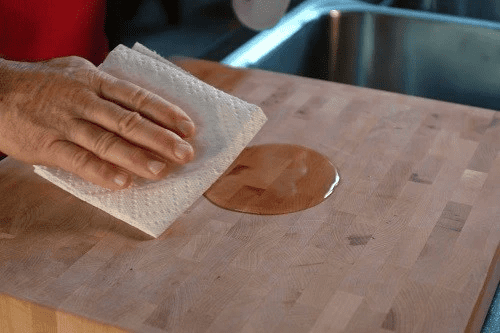
Source: Hardwood Chef
Conclusion
Working with a cutting board that’s not adequately cleaned and has strong odors is risky.
First, your cutting board will mess with the smell and safety of the food. Secondly, your cutting board isn’t safe from unexpected damage.
The process in this guide covers how you can disinfect your wooden cutting boards. Most of the processes are DIY tasks that you can take on. You’ll only need a few materials, and you’re good to go!
Always remember to rinse your wooden cutting board and air dry it after each of the disinfecting methods.
![Wood Cutting Board Vs. Plastic Board [Which is Safer?] Wood Cutting Board Vs. Plastic Board [Which is Safer?]](https://houseadorable.com/wp-content/uploads/2023/01/wood-board.jpg)
![27 Types of Cutting Boards Explained [Buying Guide Included] 27 Types of Cutting Boards Explained [Buying Guide Included]](https://houseadorable.com/wp-content/uploads/2022/12/cutting-board.jpg)
![Charcuterie Board Vs. Cutting Board [8 Differences] Charcuterie Board Vs. Cutting Board [8 Differences]](https://houseadorable.com/wp-content/uploads/2023/01/316322082_5650827684977137_862859335334204275_n.jpg)
![Bamboo Vs. Wood Cutting Board [9 Differences Explained] Bamboo Vs. Wood Cutting Board [9 Differences Explained]](https://houseadorable.com/wp-content/uploads/2023/01/cutting-board.jpg)
![Is Acacia Wood Good For Cutting Boards? [Explained] Is Acacia Wood Good For Cutting Boards? [Explained]](https://houseadorable.com/wp-content/uploads/2023/01/wood-table-top-with-acacia-chopping-board-with-blur-kitchen-counter-background-is.jpg)
![Can Cutting Boards Dull Knives? [Answered + Explained In-Depth] Can Cutting Boards Dull Knives? [Answered + Explained In-Depth]](https://houseadorable.com/wp-content/uploads/2022/11/knives.jpg)
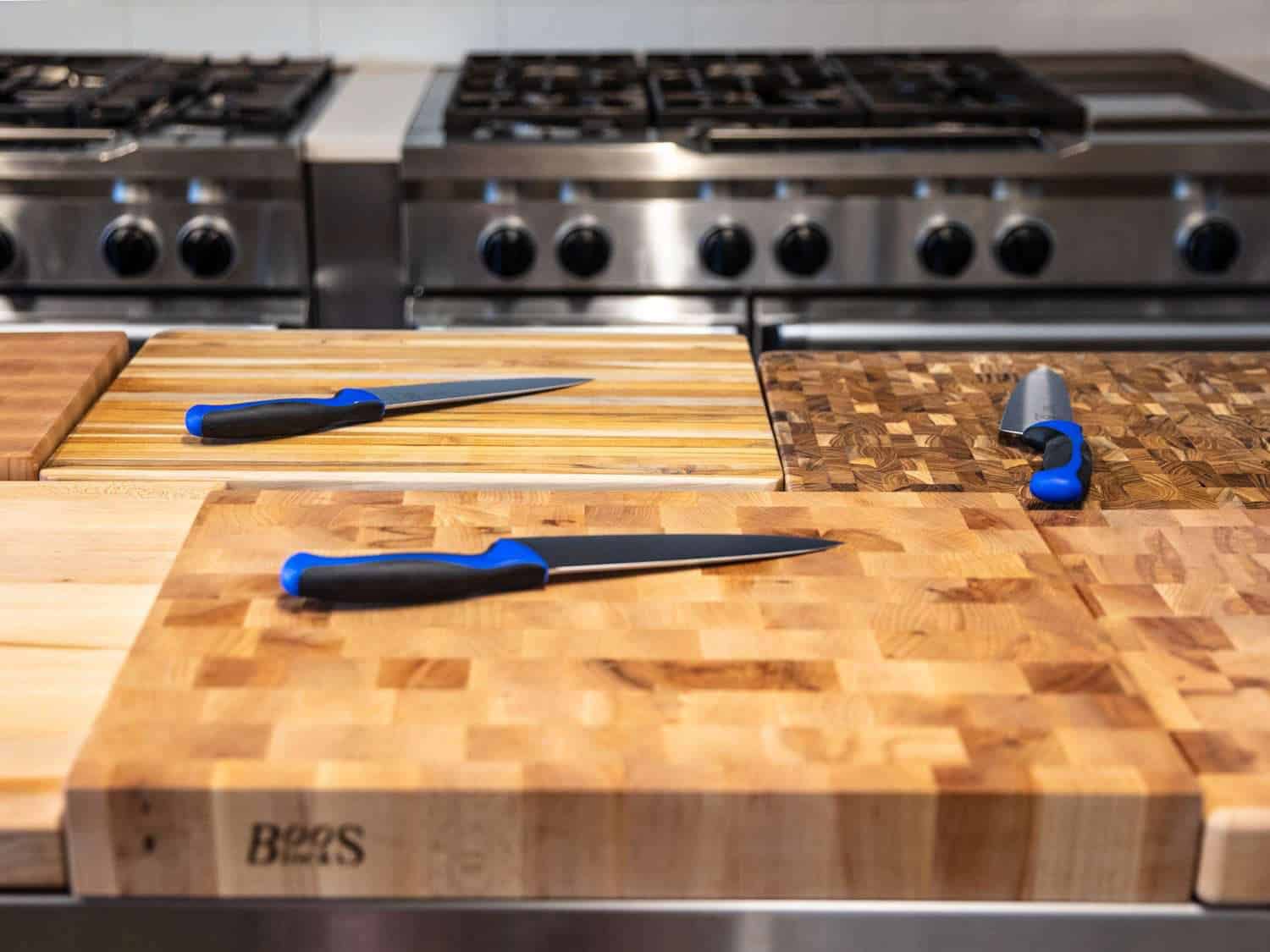
![Is Bamboo Wood Good for Cutting Boards?[8 Reasons Explained] Is Bamboo Wood Good for Cutting Boards?[8 Reasons Explained]](https://houseadorable.com/wp-content/uploads/2023/01/316002766_5887666997938019_9068589372518329358_n.jpg)